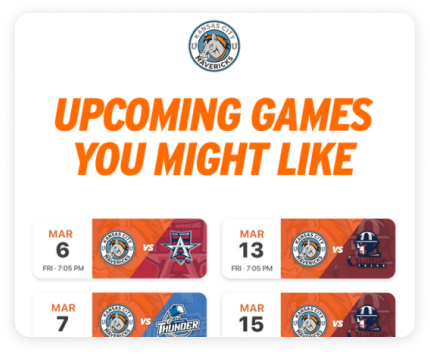Revenue
Target fans who engage with your brand but do not buy a ticket 👻
Easy

Overview
Fans who purchase merchandise, watch your events on television, or engage with your content but somehow haven’t bought tickets to an event are a perplexing but extremely valuable subset of fans. Target this group with a special ticketing offer, and it may finally give them the nudge they need to purchase tickets for themselves.

Why it Matters
There are a number of reasons why fans engage but do not purchase tickets. They could live out of state, have financial restraints, or have busy lives that make it hard to make it to an event. No matter their reasoning, they see value in the relationship with your team and are showing a continued interest.
Up to 15% of your fanbase may be engaged non-buyers
Tip — Consider sending a non-ticketing offer to these fans to see a potential lift in merchandise spend.
Getting Started
When approaching this play, consider a few things:
- Frequency — Constant touchpoints may be too much for this type of audience as they already have a strong relationship with your team and brand. Pushing tickets prior to every event may be overwhelming, so consider highlighting your most exciting events or events that run the risk of lower attendance.

- Audience — Consider narrowing the focus of this audience by layering on attributes like distance to venue or recent engagement to find fans who are close by or for whom your team is top of mind.
- Incentive — Love them or hate them, incentives work. An exciting offer for attendees may be exactly what it takes to get these fans to buy a ticket.
Lastly, work with your team to create a memorable and reusable template for an easy set-it-and-forget-it experience. You can make a monthly email highlighting all the upcoming events, or an email you send out the week of the event to create more urgency around purchasing.
Tip — We recommend including a few key components that will change for each event and provide an added layer of excitement. For instance, highlighting a rivalry, having a theme night, doing a giveaway, or hosting a special sponsor event.
Send your email
FTS Email
- Design your template in SendGrid.
- In FanThreeSixty, click to the Email section and start a new email.
- Click Automated and then Custom Automation.
- Choose Engaged non-buyers as your audience.
- Click Add Email and choose a schedule. Depending on what kind of email you want to send, here are some options:
- For a monthly email — The first of the month, early in the day (i.e. 9:00 am)
- For a week-of-event email — One day in advance of your next event, early in the day (i.e. 9:00 am)
- Select the template you built in SendGrid. Send a test email to verify everything looks correct, then click Start Sending to send the email.
Third Party Email
- On the Audiences page in FanThreeSixty, click on the Engaged Non-buyers card.
- Click Use Audience, then Export Fans.
- You can export the list of fans as a CSV, drop it to an SFTP, or push it directly into your email provider if it is directly integrated.
- Design your template in your email provider.
- Import the list that you exported via FanThreeSixty and choose these fans as your recipients.
- Schedule your email to send. Depending on what kind of email you want to send, here are some options:
- For a monthly email — The first of the month, early in the day (i.e. 9:00 am)
- For a week-of-event email — One week in advance of your next event, early in the day (i.e. 9:00 am)
Read more in the FanThreeSixty Knowledge Center:
Sending an email with FanThreeSixtyMeasuring Success
Creating a template that can be used multiple times for Engaged Non-buyers will help prevent extra workload throughout the season. Once your email has been deployed, track engagement and clicks over time to see how the email is performing. Also, keep an eye on the total number of fans who purchase tickets after receiving the email—this is a key metric that can help determine if your play is successful.

Playbook by FanThreeSixty. © 2021